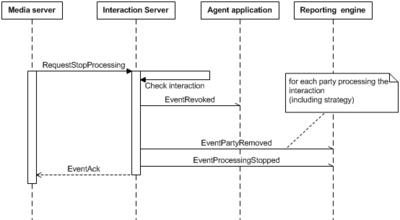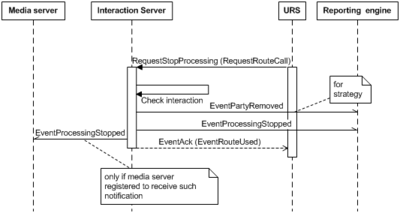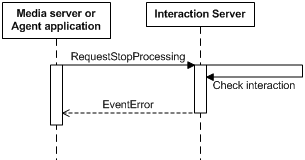Contents
Stop Processing
This scenario has several versions, depending on these two points:
- Which entity initiates the stop processing request: media server, agent, or URS
- If a media server initiates the request, there is a further difference according to whether an agent or URS is involved in processing.
This produces four possible versions, called A, B, C, and D in this section:
-
A—Initiated by media server, agent involved in processing
-
B—Initiated by media server, URS involved in processing
-
C—Initiated by agent
-
D—Initiated by URS
A: Initiated by Media Server, Agent Involved
In this version, shown in the following figure, an agent is processing the interaction when a media server asks for processing to stop.
This version uses the messages listed in the following table:
| Message | Protocol |
|---|---|
| EventAck | Interaction Management |
| EventPartyRemoved | Reporting |
| EventProcessingStopped | Reporting |
| EventRevoked | Interaction Management |
B: Initiated by Media Server, URS Involved
In this version, shown in the following figure, URS is processing the interaction when a media server asks for processing to stop.
This version uses the messages listed in the following table:
| Message | Protocol |
|---|---|
| EventAck | Interaction Management |
| EventPartyRemoved | Reporting |
| EventProcessingStopped | Reporting |
| EventAbandoned, used here in place of EventRevoked | T-Library |
This model uses the T-Library EventRouteUsed to stand in for the Interaction Management EventRevoked.
C: Initiated By Agent
In this version, shown in the following figure, an agent initiates the stop processing request.
This version uses the messages listed in the following table:
| Message | Protocol |
|---|---|
| EventAck | Interaction Management |
| EventPartyRemoved | Reporting |
| EventProcessingStopped | Reporting |
| EventRevoked | Interaction Management |
D: Initiated by URS
In this version, shown in the following figure, URS initiates the stop processing request.
This version uses the messages listed in the following table:
| Message | Protocol |
|---|---|
| EventAck | Interaction Management |
| EventPartyRemoved | Reporting |
| EventProcessingStopped | Reporting |
| EventRouteUsed, used here in place of EventAck | T-Library |
This phase uses the T-Library RequestRouteCall to stand in for the Interaction Management RequestStopProcessing. It also uses the T-Library EventRouteUsed to stand in for the Interaction Management EventAck.
Unsuccessful
In this version, shown in the following figure, Interaction Server finds that the request is invalid and rejects it.
This version uses the messages listed in the following table:
| Message | Protocol |
|---|---|
| EventError | Interaction Management |





